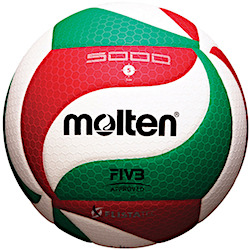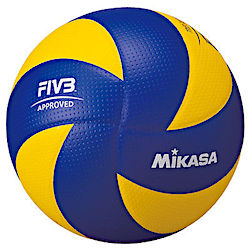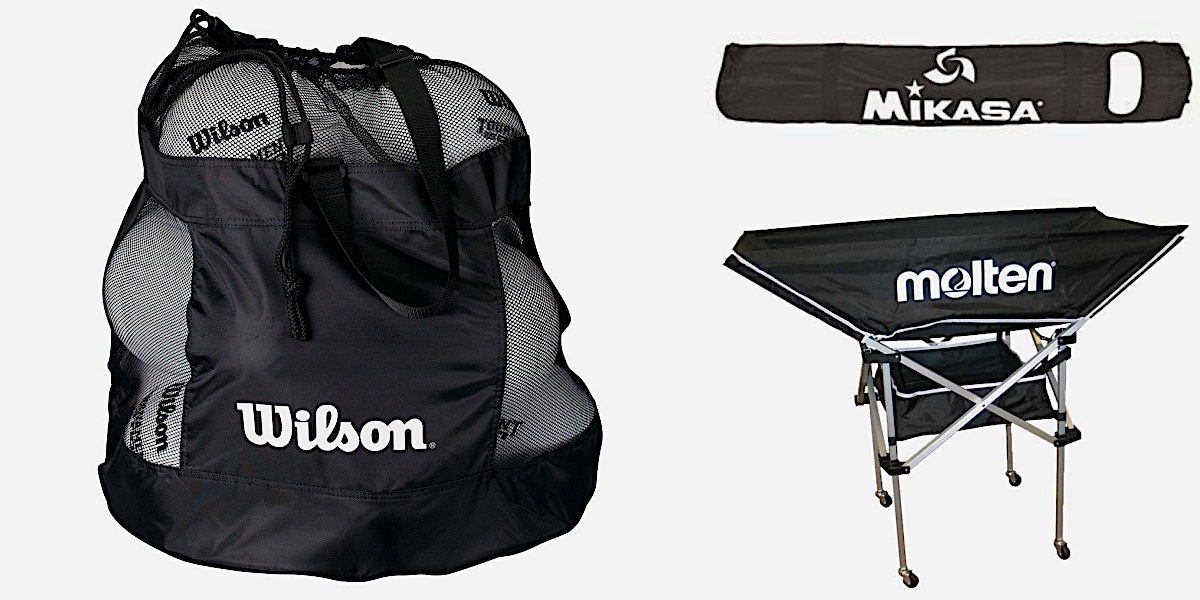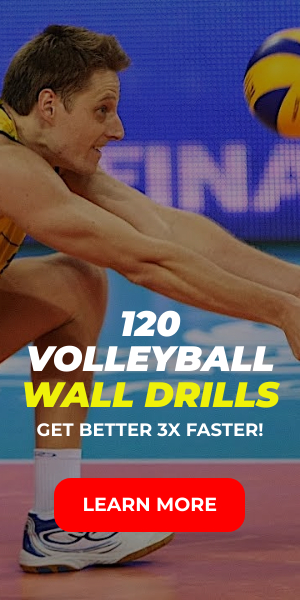One of the most popular sports in the world today is volleyball. No one can discount that the most important part of the game is the actual volleyball ball. The game was created in the late 1800s and since that time the ball has remained the center fixture of play. Learning how to maneuver and control the ball is the main goal of any player—whether on a pro team or a hobbyist. The use of the ball is something that players can take a lifetime to master, which makes for the most challenging and enjoyable part of play. Here are some details on the volleyball’s progression and how it has come to be the most important element of the game.
- What is a volleyball
- History of volleyball ball
- Indoor vs Beach volleyball balls
- Professional indoor volleyball balls
- Top beach volleyball balls
- Ball speed and reactions
- Materials
- How to inflate
- Sizes
- Official balls in most important leagues
- Balls for kids
- Volleyball ball bags
- Care instructions
1. What is a volleyball
A volleyball is a piece of volleyball equipment together with shoes, volleyball knee pads etc. Volleyball is designed specifically for use on the various floors the game takes place on. There are definite differences between a ball designed for court floor and for beach play. What is consistent is that the ball is round and usually has eighteen rectangular-like panels of leather—either synthetic or genuine—arranged on six different panels. This leather covering is wrapped around the bladder of the ball. What is interesting is that because of its design, it can take on many different exciting colors as dependent on the team using it. It has a distinct look, so you’ll know it is a volleyball ball, but it still has its own ability to be dressed in flair as needed.
In 1947 France created the FIVB which was a governing body to dictate the rules and regulations. What that meant for the volleyball was it would be standardized throughout gameplay. Consider if different teams had different quality balls to play with. Even a slight difference in mass and flight ability can drastically change a player’s reaction and control. Try playing volleyball with a youth-sized ball and then a standard one. You can easily see right away how different they are. That’s not to say a smaller ball isn’t valued in the sport. They are great tools to use to start off the game. If you’re focusing your new player on learning control and going through drills, a lighter ball can help dramatically. Once they get to the big courts though, they have to transition to a standard ball and understand how to translate their skills to accommodate the greater size and weight.
The FIVB remained highly involved in the evolution of the sport. In 2008 they decided that the Mikasa ball with eight panels and with dimples in the body would be the official indoor ball for volleyball sports. What made it so useful for indoor play was its soft-to-the-hand touch and more streamlined flight capability. It also came with a valve that allowed for adjustment of the internal air pressure of the ball.

William Morgan
2. History of the volleyball ball
The volleyball ball itself was needed when the game was created by William G. Morgan in 1895. His design of the game was to use a net and a ball. At the time, there were some volleyball balls to pick from, but they weren’t exactly right for the high-performance game. The different moves needed to manage the ball required a ball that was specific to the setting. Think of what a volleyball needs to do throughout any given game:
- It has to be kept airborne throughout a play
- It has to be light so that it can be kept airborne
- It can’t be so light that it is easily shifted by winds
- It also can’t be so light that it only moves slowly due to resistance
At the time of volleyball’s creation there were no balls that would completely fit the bill as Morgan needed. Originally players and teams used volleyballs that were created with the bladder that a basketball used. The bladder of a basketball however proved to be too slow in the air because of its lack of weight. Some players tried using makeshift balls by substituting basketballs. Again- this didn’t work too well because the balls were too heavy to maintain air like they needed.
In the end, Morgan approached A.G. Spalding and Brothers to ask them to custom-make a ball that would be the official volleyball. At the time Spalding was a huge name in the world of baseball. They were the ones that had the expertise to create a new ball that worked for the needs of this newer game. The initial configuration of the volleyball ball was a latex bladder that was constructed out of a material similar to a bicycle tire. The second layer over that material was a cheesecloth-like material surrounding it. On top of that was a third layer of leather sewn around the ball.
Spalding’s manufacturers took their expertise with baseball and brought it to the game of volleyball. The ball was more streamlined and solid for excellent flight, but not too heavy either. Modern-day volleyballs have not changed much since the initial configuration. The bottom line for them is that they worked so there has been no real need to recreate them.

old volleyball balls
What has changed though with the balls is the outer panel. Originally the leather outer covering was stitched to the inner bladder with an 18-panel construction. If you look at historical balls you can see the distinct look of the ball. It was easy to imprint logos and different colors on the ball with these multi-panel looks. In 2008, however, the look changed. The impetus was the Olympic Games set for that year. Mikasa, a leader in the world of volleyballs, developed and created a newer design that they allowed for optimum hand contact to the ball. This new design was an 8-panel one. After testing, it was proven that the newer lesser-paneled ball offered more accuracy to players. It was also developed with dimples that played to the flight pattern of the ball. Interestingly, this was the first time the design of the volleyball had changed throughout its 100-year history in sports.
Since 2008, more modern balls have been standardized to a weight of 9 to 12-ounces and a ball circumference of 25 to 27-inches in diameter. These are the general guidelines of balls used in all pro sports and in many training sessions. The volleyball ball itself has stayed true to the original configuration with just a few minor alterations in the past decade.
Understanding the details of volleyball equipment, like the ball, is essential for players. Similarly, a casino without Swedish license provides gaming options that cater to players looking for unrestricted access to games.
3. Indoor vs Beach volleyball balls
When it comes to the volleyball, the setting is definitely a concern. What works indoors in terms of the ball, does not work outdoors on the beach. Each setting requires its own specific ball to accommodate the elements it faces. Namely there is the beach setting and the indoor setting. Just think of how different they are and you can imagine the different style equipment needed for each.
- The indoor setting. Indoor setting for volleyball includes a court floor. These balls are a combination of two or three different colors, or they can be completely white. There are two different styles: youth and adult. The youth volleyball ball for indoor use is 63 to 65-centimeters or 25 to 26-inches in circumference. They weigh 9.2 to 9.9 ounces, or 260-280-grams. Internal pressure of these balls are set at 4.3 psi or 0.30-kgf-per-centimeter-squared. The adult indoor volleyball ball is 65 to 67-centimeters or 25.5 to 26.5-inches in circumference. They weigh 9.2 to 9.9-ounces or 260 to 280-grams. They have a psi of 4.3 to 4.6, or 0.3 to 0.325-kgf-per-centimeter-squared. There is not a lot of different between the two when looking at the numbers, but for different play styles of the adult versus the youth, they are notable. Remember that youths have to be able to palm the ball and force it over the net. Having a slightly smaller size, with a lower psi can considerably aid them in doing this. You’ll notice that both balls are very streamlined and light-weight in characteristic. Again, this is for ease of movement of the balls during a high-energy game where timing is critical.
- The beach setting. With the beach volleyball game there are a lot of outdoor elements that the ball will have to weather that aren’t there with inside gaming. The heat of the sun, the UV rays, the sand, etc. These completely change the psi requirement. Beach volleyball balls are between 66 to 68-centimeters in circumference or 26 to 27-inches. They have a general mass of 260 to 280-grams or 9.2 to 9.9-ounces. Their psi is set at 2.5 up to 3.2, or 0.175 to 0.225-kgf-per-centimeter-squared. You’ll notice that the psi is the only thing drastically different than the indoor ball. This is because of the surface that the ball is required to bounce off of. Sand is much different than court room floor; this warrants a lower psi to accommodate efficiently. The beach-intended volleyball ball is also slightly larger than indoor balls and has a rougher texture to the outer coating. This coating plays perfectly to the outdoor needs of the game.
If you are playing the game of volleyball, it is important to practice and play with the right equipment and that includes a ball that is designed for your setting. This can affect your entire game and give you the edge you need when it comes to earning a win. Having the wrong ball, or practicing with one, will be strategically very different if you are using the inappropriate equipment and that includes the ball you choose for your game.
4. Professional indoor volleyball balls
The professionals all have their favorite indoor volleyball balls. They are designed for comfort, ease of play and managing their setting well. Here are the three top indoor volleyball balls and their history.
Tachikara SW5WSC. Tachikara is a Japanese company that was first founded in 1915. They specialize in sports equipment in general, but have a very keen interest in volleyball balls also. In fact, this is what they are most known for. They are the official ball of the women’s volleyball NAIA, or National Association of Intercollegiate Athletics, and the official volleyball of China, Oceania, Africa, Canada and Europe. The Tachikara SW5WSC is one of the most highly touted pieces of equipment the company designed. It is created with a Butyl bladder and coated with T-Tech micro-leather for streamlined performance. What is standout about this design is its noted attention to the tactile play style and how the outer coating plays perfectly to accurate management of the ball during a high-energy game.
Molten FLISTATEC 5000. This is another company based out of Japan and like Tachikara, it is a leader in creating sports equipment. It makes basketballs, volleyballs, footballs and other styles of handballs for intense and official use. Their basketballs are the official ones used for the FIBA, or International Basketball Federation. Their volleyballs are the official balls for the US national teams and the youth teams since 1997 and 2001, respectively. Their Molten FLIPSTATEC 5000 is also the official ball of the NCAA men’s division and used by many different collegiate conference games. It offers outstanding control of the ball and its structure increases its stability during flight and visibility. What makes this different is that the ball is built with the ability to maximize its surrounding air-current when in flight and also is easy to grip.
Mikasa MVA200. Mikasa is another corporation that sells sports equipment and is based out of Japan. Their volleyball balls are the official ones used by the FIVB in worldwide competitions. They also provided the official equipment for the London Olympics of 2012 and 2016. The Mikasa MVA200 is an 8-panel design that has special aerodynamic dimples throughout its outer body. These dimples make ball handling that much easier. It boasts a highly engineered design that plays perfectly to the stability and control of the ball when in high-intensity gameplay. This is a high priority with players and the Mikasa brand focuses on elevating gaming to a higher level. This ball in particular has an exclusive micro-fiber covering that is soft and a nylon center. The MV200 is one of the top indoor balls available and when you play with it, you’ll find a definite difference in dexterity and control.
5. Top beach volleyball balls
Outdoor balls are designed differently to accommodate the outdoor environment. The balls are notably larger than the indoor ones and they have a lower psi. The mass of the two are generally the same. Here are two of the top beach volleyball balls in the market.
- Mikasa VLS300. The Mikasa VLS300 is one of the best outdoor beach volleyball balls available. This one has a soft composite cover and is the official ball for the FIVB games. What makes it so unique is its 10-panel design and improved resistance to water. It also has a double cloth backing that helps it to maintain its shape throughout high-intensity play. This is another ball that has the technology needed to make it a star ball on the circuit. The focus here is elevating the handling ability of the ball, which is exactly what Mikasa does.
- Wilson AVP. The Wilson AVP is another ball specifically made for the beach and grass. It has an outer coating that is much more resistant to the moisture and dirt than other styles. It is leather is able to resist tarnish thanks to Wilson’s microfiber composite construction. It has an 18-panel covering that is hand-sewn for accuracy and detail. It follows all the high standards of the AVP and can hold up to just about any outdoor game you want to put it through. This is the game you want on your side if you’re in the midst of a harrowing and high-intensity game at the beach.
What you’ll notice about the beach volleyballs is that they are made with an added outdoor-element resistance. Not only does this make them easier to maneuver when outdoors, but it maintains the life of the ball for much longer…even after it is put to task time and time again.
6. Ball speed and reactions
One of the biggest concerns with volleyball balls—whether indoors or outdoors—is the ball speed and how it affects reaction time. Recent studies have shown that the professional player can spike the ball up to 80-mph! That’s an amazing feat that takes a few things to happen—first of all, it takes a lot of skill from the player. Second, it also requires a lot of power and the knowledge on how to direct that power. Finally, it takes the right construction of ball. This is where the companies that make them come in. They do extensive studies on what works, and what doesn’t in terms of optimizing the performance.
According to records, it was Matey Kaziyski of Bulgaria who set the world record spike of about 80.1-miles per hour. Though that is the top speed, on average a collegiate competition can reach anywhere from 50 to 60 miles per hour. Usually high school players average from 40 to 50 miles per hour. The fact is that over time, players gain the ability to spike the ball much harder thanks to their development of skills. It is the player’s execution of the strike on the ball and their effectiveness with technique that play instrumental roles in how fast the ball moves. The body angle, degree with which it is struck and how his or her hand connects to the ball dictate the ending velocity of travel. This is a much coveted skill because the best players can be effective offensive assets to the team. A team player who has an effective attack with the fastest spiking ability can frustrate any block and usually keep the other team’s defense hard at work.
What makes spiking so helpful for a team is its requirement of the other team to have a fast reaction time. Imagine how much more innate skill is required from a ball that is rushing towards the floor at 60 miles per hour, than for a ball falling to the floor at 40 miles per hour. The fact is that the faster ball makes the other team’s defense jump. If they don’t have time to set up their shot, they can easily fall short and lose.
One thing that volleyball players work on over and over again is their reaction time. Coaches will use 2-point start drills and wall drills to work on a player’s response. The goal is to make the movements automatic so when the big game is on, the players don’t even think about what their responses will be. Their bodies automatically rush to action. It takes time to get this kind of adroitness though so if you plan on engaging in the sport, expect to spend a lot of time with the volleyball and learning the handling techniques needed for efficient game play.
7. Materials
What sets one volleyball ball apart from another are the materials it is made of. Lower quality material makes mediocre balls. If you look at the balls that are approved by the FIVB or other professional organizations supporting the sport, you’ll notice that they have officially approved volleyballs. The reason is because they want to give their players the best equipment possible that can really showcase their talents and hard work. In general, there are three different parts of the ball:
- The outer shell. Usually the outer shell is made of high-quality leather or a synthetic leather. Indoor volleyballs are made of different panels that are glued securely to the inner lining. This is a way to make the seams look smoother. That smoothness plays to the court floor because if a hefty seam were to hit the floor, it would cause the ball to veer off in an unexpected direction, likely putting the player in a difficult, if not impossible, position. That smoothness is needed to ensure that the ball will move in an anticipated way allowing the player to work with it. When it comes to beach or outdoor volleyballs, they are made of panels that are secured to the inner lining. If you look closely at the ball, you’ll see the threads and the holes and how it is held together with the panels. In an outdoor setting smoothness is not as high a priority, though it is still a desired quality for the ball.
- The core. The core of the ball is called its “bladder”. It usually is made of a rubber core. The reason for this is that it is very lightweight. Remember that most volleyballs fall into a weight range of 9.2 to 9.9-ounces…not much room for any weighty core. This not only allows the ball to fly easier and more smoothly through the air, but it gives players the ability to work with the ball and not strain themselves. Just think of a player who has taken a shot to the arms time and time again. You likely will see a person with very red forearms. Without the lightness of the ball, this could be much worse for the player.
- The panels. In the past the exterior of a volleyball had 18 panels around it. The official balls though for the Olympics and other professional leagues are tri-colored and have 8 panels. There are different reasons why the panels are there but what is important is their effect. They help the ball to stay firmly together and streamlined for play.
The ball in the game of volleyball is a key piece of equipment. Imagine if it was flimsy? Imagine that flimsy ball playing with top-notch players in a championship game. There is no way the outcome would be the same as playing with a regulation ball to help gain the victory!
8. How to inflate
When it comes to maintaining your volleyball ball, there are some things you should get accustomed to doing. One of the most important is knowing how to inflate it. The professionals keep the psi of a ball at 0.3 to 0.325 for indoor balls and at 0.175 to 0.225 for beach, or outdoor, balls. This is a good guideline to keep your equipment at if you are in charge of its maintenance.
There are a few ways you can inflate the ball. You can use an air pump. If you do choose this route, be aware that there are many different styles of gauges you can use to monitor the psi. Your pump may come with a needle, but if it doesn’t you’ll need to purchase one. Connect the needle to your pump. Moisten the needle with water and then inset it into the ball’s air hole. If you have a difficult time finding the hole, check with the manufacturer to see where it is located. Due to design, some are more difficult to locate than others. Next you should start pumping. As you do, stop every three-to-five pumps to check the ball’s pressure. Remember the psi you’re searching for. Another rule of thumb is to drop the ball from chin height. It should bounce back up about 60-percent if it is properly inflated. This of course is just a guide; the most accurate thing to do is stick to the psi reading.
If you have a machine for inflation, then you’ll also be able to get your ball up to standard psi quickly. The only thing to watch with an air compressor is that sometimes it is easy to get overzealous with the pump. Be sure that you monitor progress often, in particular if you have a larger compressor. With this option you most likely will have to have your own needle. Plug the machine in an outlet and get it up and running before you connect it to the ball. Once it is running, you can inject the needle. Fill until the ball feels firmer and then use your gauge to check its psi. Again, when you are done check the 60-percent test to make sure that the ball is inflated to where it needs to be.
9. Sizes
You are going to find different sizes of volleyballs available. Some people encourage young people to use smaller weight and size balls for practice when they first begin in the sport. Though getting on the court with only experience on a smaller ball may not be helpful, there is some value to the smaller size balls. In particular, when learning the skill of bumping a smaller ball can be less impactful on the forearms. If you have a child who is just learning the sport, this can be a great way to get them used to the sound, impact and force of the ball. As they become more familiar and accustomed to it, you can transition them to a larger, standard-sized ball.
A smaller ball is also great to start working with if you plan on doing drills to hone skills like bump, set and strike, or serve and bump. Again-your child or a newer player may appreciate the smaller sized ball that allows them to practice these skills without harming themselves. The important thing is to help them get used to the feel of the ball and how to work with it. They also should get used to having and keeping control over the ball when they go through various drills. It is critical to keep in mind that the goal is to get them to a standard size ball when they are able to maintain control of the smaller one. In particular if they plan on pursuing the sport as a hobby or even as a professional they will have to be used to the larger size ball and how to maneuver it.
As stated earlier, there are different sizes of volleyballs. They vary slightly based on the setting they are used in. It makes sense too—consider how different an indoor court volleyball game is to an outdoor beach volleyball game. Each one comes with its own challenges and the balls are designed to take on these issues as efficiently as possible for players. Here are the sizes of volleyballs based on where they are used:
| Type | Circumference (inches) | Mass (ounces) | PSI (psi) |
| Indoor ball | 25.5-26.5 | 9.2-9.9 | 4.3-4.6 psi |
| Youth ball | 25-26 | 9.2-9.9 | 4. 3 psi |
| Outdoor ball | 26-27 | 9.2-9.9 | 2.5-3.2 psi |
Note that though the circumferences and psi change dependent on setting, the mass doesn’t. It will always be somewhere between 260 to 280-ounces. This is a standard set forth by the league and helps players to maneuver the ball whether inside or outside for their play. As a reminder, though you may start a player at a smaller mass ball, always move to the standard size as soon as they are comfortable.
10. Official balls in most important leagues
coming soon…
11. Balls for kids
It is no secret that volleyball is a great pastime of kids everywhere. They love the high-energy sport (and so do their parents!). There are a lot of different balls for kids available. What you’ll find is that these balls are lighter and sometimes smaller in circumference. This is a great way to train children on the skills and techniques needed for the game, but lessen the impact on their arms and hands as they manoeuvre the balls. It lets them grow accustomed to controlling the ball and then slowly expand their skills to a regulation-size.
When purchasing a ball for kids under 12-years old, it is important to recognize their fears and limitations. As a new sport, it may be intimidating for them to get used to the strike and noise of a volleyball on their hands and arms. If they watch the pros, it may be even more difficult. For a new player it is daunting to see how they manage the ball. The important thing to know though is that you can ease them into the sport with a ball specifically made for kids.
All of the larger manufacturers like Mikasa, Tachikara, Wilson and Molten make youth-sized balls to start with. You can find balls for kids under 12-years old and kids over 12-years old. For those under, the balls can be particularly light in weight at just 7-ounces. Standard balls are at 9.2 to 9.9-ounces so you can see the disparity for beginners. The smaller balls also are about 30.5-inches circumference, notably smaller than the standard 26-inches on average. By bringing the weight and circumference down, your child will be able to practice skills in a very laid-back fashion. They won’t have to worry about the impact of a hefty ball until they are ready to manage it.
If your child is over 12-years old, you can also find slightly larger volleyballs that are still under professional regulation. They help to give the player time to get used to the ball and keep control over it, prior to getting on the court for an actual game. You can find volleyballs in this category that range from 31-inches up to standard circumference, but are lighter. They are from 5.5-ounces to 8.1-ounces. Again- this lighter construction makes it easier for players to get used to the balls and controlling them as they maneuver.
When looking for a ball for a kid, be sure that you consult the manufacturer and start with the balls they specifically make for youth play. These are just as high-quality as the pro balls, but they are lighter and smaller. Some pros even use them to practice the repeated drills they go through as they continue to hone skills. In particular, they are great tools to help children learn how to control the ball and then ease their way into the standard sized ball as they develop confidence with the game.
12. Volleyball ball bags
Another thing you will want to do for yourself if you’re a player, or for your kids who play volleyball is to find the right ball bag. There are a lot of different options available, so you want to be sure that you know what you should be looking for. Here is a general guideline on what to look for with any bag product you are considering for purchase:
- Style. In the market you will find a variety of different bag styles from duffels to drawstring bags and backpacks to volleyball-specific carriers. For the most part, you should consider the individual user’s habits when deciding on what style of bag to purchase. For example, if you plan on jogging to the gym every Saturday for a pick-up volleyball game, are you going to want a drawstring bag on your back that is bouncing with your movement? Most likely not! On the other hand, if you plan on throwing your bag into your car to go to the game, then you may not care as much what style of bag you choose. Always consider how far you will actually be carrying the bag and how you will transport it. Do the same for children as you choose their ball bags.
- Durability. Durability is another issue that you should consider. If you play volleyball a lot and need to use your bag a lot, then be sure to get a top-notch bag. You want to get your use out of it without it breaking or tearing after repeated use. Again, consider your specific use. You can find bags that are created with waterproof technology and are abrasion-resistant. These are usually worth the extra cost due to how much longer they last. If you’re purchasing the bag for a child, for example, who likes to jump from one sport to another, then the higher cost of a durable bag may not be needed. On the other hand, if you have a high school player who is on the team, then you may want to invest in a better bag for long-term use.
- Compartments. You can find some very simple volleyball bags with just one main compartment. You can also find some intricate bags that let you carry just about everything you possibly could think of. The one you pick is dependent again on your lifestyle. Some people just carry their ball and are able to make quick trips home for everything else. Other people like to pack their shower toiletries, a towel, a change of clothes, shoes, makeup and their ball with them at all times. The good news is that there are enough bags available that you can find exactly what you want and need. Think about what you or your child needs to carry with them when they go to the court or the beach and pick a bag accordingly. You can find plenty of affordable options that are well within your budget regardless of what you want.
- Name brand. There is a lot of debate here whether or not a name brand bag is higher quality. In general, you will find that name brand and cost go hand in hand. Nike, Under Armour and The North Face all offer options. What works best though is to look at the makeup, durability and style of a bag. The bag you choose should fit the bill for all three of these, prior to considering the name brand of a bag. This is the best way to get the exact bag that you need when you gear up for your volleyball lifestyle. You also can find plenty of workable options on sale. Again- if this purchase is for a child, be sure you take into consideration their true devotion to the sport and how long you think they will be involved in it.
- The extras. As you sort through the options you’ll find that there are also some extras out there that really play to your needs. Some backpacks have wheels. This makes heavier bags easier to maneuver. Others come with side water bottle pockets. This is a convenience that only you can say whether or not you really need. Here is where you consider color too—if your team has certain colors they focus on, you may want to stay uniform with it. If your child is the one you’re making the purchase for, you may have to stay within a certain color scheme. Remember thought that the extras can usually be negotiated. Stick to the real quality aspects of a volleyball bag when making the initial decision. This is the best way to ensure that you’re getting your money’s worth with the purchase.
13. Care instructions
Regardless of what type of volleyball you end up purchasing and playing with, you need to maintain specific care instructions. There are a lot of different ways that people limit the amount of time they will have a workable ball. First, some people leave their volleyballs outside. If you’re a beach player, this can happen a lot. After a game, you just put the balls used in a corner and go about your day. Though this happens time and time again, it seriously lessens a balls lifespan. Another thing people do is throw their volleyball into the trunk of their car or in a garage. These are great places where the temperatures can soar—not good for your volleyball! The best thing to do is to always store your volleyball in a room-temperature location where it will be dry and clean. You want to avoid any long-term harsh environment. This only causes your ball to deteriorate that much faster
Another thing people do is throw their dirty ball into its storage spot. Dirt should never be left on your ball. After a game—even an indoor game—the ball likely is covered with dirt and scuffs. This goes even further if the ball is used outside. Sand can be just as damaging to the surface of a ball as a harsh court floor. Here are the steps you should take when it comes to keeping your volleyball clean:
- Use a soft cloth to wipe the surface of the ball. This is the best way to dislodge any dirt, sand or debris from the surface.
- If there is still dirt on the ball after you wipe it with a soft cloth, then moisten the cloth and try again. Here is where the wet cloth will help to pick up dirt.
- If there is still dirt on the ball after you wipe it with a soft moist cloth, then use a very mild detergent. Never put the detergent full strength on the ball though. Be sure that you mix detergent and water together at a 1-to-10 mix. It helps to put one small capful of detergent into a ½-gallon of water. Shake it up and then use a soft cloth to work on the dirty spots of the volleyball.
- Be sure to rinse off the detergent well after you get the dirt off. Leaving detergent on the ball can discolor it and attract more dirt to the surface of your ball.
Once your ball is cleaned, wipe it dry with another soft cloth. Place it in a well-ventilated location, but not in direct sunlight that can fade it. It is important to dry the ball with air and not a hair dryer or another dryer in the gym’s locker room. Many people think this is a quick way to dry it, but it actually can damage the ball’s makeup.
When you store your clean volleyball ball, be sure that you keep it at the right pressure. Some people like to deflate the ball a bit for storage, thinking this will keep its lifespan longer. This is not true and can cause wrinkles in the ball that don’t come out upon re-inflation. Again- store the ball away from the sunlight or any very hot, very moist or very cold conditions.
CONCLUSION
Volleyball is a great game that has sustained its reputation for fantastic fun and competitive play for over a century. If you are looking for a high-energy game that supports teamwork and athleticism, then this may be the perfect sport for you!









